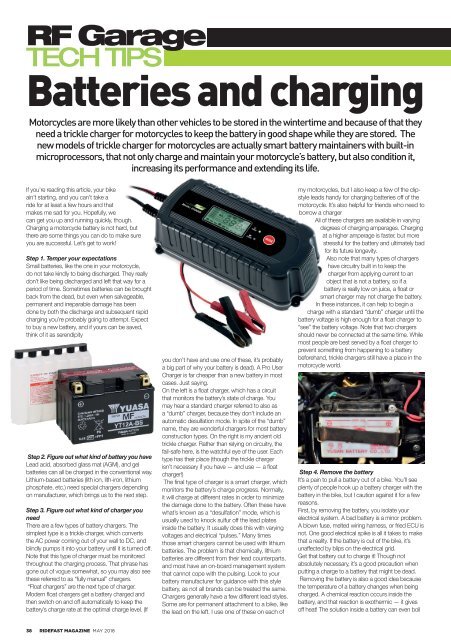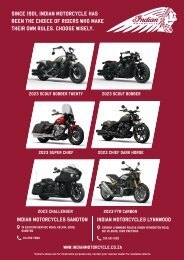RideFast May 2018
Create successful ePaper yourself
Turn your PDF publications into a flip-book with our unique Google optimized e-Paper software.
RF Garage<br />
TECH TIPS<br />
Batteries and charging<br />
Motorcycles are more likely than other vehicles to be stored in the wintertime and because of that they<br />
need a trickle charger for motorcycles to keep the battery in good shape while they are stored. The<br />
new models of trickle charger for motorcycles are actually smart battery maintainers with built-in<br />
microprocessors, that not only charge and maintain your motorcycle’s battery, but also condition it,<br />
increasing its performance and extending its life.<br />
If you’re reading this article, your bike<br />
ain’t starting, and you can’t take a<br />
ride for at least a few hours and that<br />
makes me sad for you. Hopefully, we<br />
can get you up and running quickly, though.<br />
Charging a motorcycle battery is not hard, but<br />
there are some things you can do to make sure<br />
you are successful. Let’s get to work!<br />
Step 1. Temper your expectations<br />
Small batteries, like the one in your motorcycle,<br />
do not take kindly to being discharged. They really<br />
don’t like being discharged and left that way for a<br />
period of time. Sometimes batteries can be brought<br />
back from the dead, but even when salvageable,<br />
permanent and irreparable damage has been<br />
done by both the discharge and subsequent rapid<br />
charging you’re probably going to attempt. Expect<br />
to buy a new battery, and if yours can be saved,<br />
think of it as serendipity<br />
Step 2. Figure out what kind of battery you have<br />
Lead acid, absorbed glass mat (AGM), and gel<br />
batteries can all be charged in the conventional way.<br />
Lithium-based batteries (lith ion, lith-iron, lithium<br />
phosphate, etc.) need special chargers depending<br />
on manufacturer, which brings us to the next step.<br />
Step 3. Figure out what kind of charger you<br />
need<br />
There are a few types of battery chargers. The<br />
simplest type is a trickle charger, which converts<br />
the AC power coming out of your wall to DC, and<br />
blindly pumps it into your battery until it is turned off.<br />
Note that this type of charger must be monitored<br />
throughout the charging process. That phrase has<br />
gone out of vogue somewhat, so you may also see<br />
these referred to as “fully manual” chargers.<br />
“Float chargers” are the next type of charger.<br />
Modern float chargers get a battery charged and<br />
then switch on and off automatically to keep the<br />
battery’s charge rate at the optimal charge level. (If<br />
you don’t have and use one of these, it’s probably<br />
a big part of why your battery is dead). A Pro User<br />
Charger is far cheaper than a new battery in most<br />
cases. Just saying.<br />
On the left is a float charger, which has a circuit<br />
that monitors the battery’s state of charge. You<br />
may hear a standard charger referred to also as<br />
a “dumb” charger, because they don’t include an<br />
automatic desulfation mode. In spite of the “dumb”<br />
name, they are wonderful chargers for most battery<br />
construction types. On the right is my ancient old<br />
trickle charger. Rather than relying on circuitry, the<br />
fail-safe here, is the watchful eye of the user. Each<br />
type has their place (though the trickle charger<br />
isn’t necessary if you have — and use — a float<br />
charger!)<br />
The final type of charger is a smart charger, which<br />
monitors the battery’s charge progress. Normally,<br />
it will charge at different rates in order to minimize<br />
the damage done to the battery. Often these have<br />
what’s known as a “desulfation” mode, which is<br />
usually used to knock sulfur off the lead plates<br />
inside the battery. It usually does this with varying<br />
voltages and electrical “pulses.” Many times<br />
those smart chargers cannot be used with lithium<br />
batteries. The problem is that chemically, lithium<br />
batteries are different from their lead counterparts,<br />
and most have an on-board management system<br />
that cannot cope with the pulsing. Look to your<br />
battery manufacturer for guidance with this style<br />
battery, as not all brands can be treated the same.<br />
Chargers generally have a few different lead styles.<br />
Some are for permanent attachment to a bike, like<br />
the lead on the left. I use one of these on each of<br />
my motorcycles, but I also keep a few of the clipstyle<br />
leads handy for charging batteries off of the<br />
motorcycle. It’s also helpful for friends who need to<br />
borrow a charger<br />
All of these chargers are available in varying<br />
degrees of charging amperages. Charging<br />
at a higher amperage is faster, but more<br />
stressful for the battery and ultimately bad<br />
for its future longevity.<br />
Also note that many types of chargers<br />
have circuitry built in to keep the<br />
charger from applying current to an<br />
object that is not a battery, so if a<br />
battery is really low on juice, a float or<br />
smart charger may not charge the battery.<br />
In these instances, it can help to begin a<br />
charge with a standard “dumb” charger until the<br />
battery voltage is high enough for a float charger to<br />
“see” the battery voltage. Note that two chargers<br />
should never be connected at the same time. While<br />
most people are best served by a float charger to<br />
prevent something from happening to a battery<br />
beforehand, trickle chargers still have a place in the<br />
motorcycle world.<br />
Step 4. Remove the battery<br />
It’s a pain to pull a battery out of a bike. You’ll see<br />
plenty of people hook up a battery charger with the<br />
battery in the bike, but I caution against it for a few<br />
reasons.<br />
First, by removing the battery, you isolate your<br />
electrical system. A bad battery is a minor problem.<br />
A blown fuse, melted wiring harness, or fried ECU is<br />
not. One good electrical spike is all it takes to make<br />
that a reality. If the battery is out of the bike, it’s<br />
unaffected by blips on the electrical grid.<br />
Get that battery out to charge it! Though not<br />
absolutely necessary, it’s a good precaution when<br />
putting a charge to a battery that might be dead.<br />
Removing the battery is also a good idea because<br />
the temperature of a battery changes when being<br />
charged. A chemical reaction occurs inside the<br />
battery, and that reaction is exothermic — it gives<br />
off heat! The solution inside a battery can even boil<br />
38 RIDEFAST MAGAZINE MAY <strong>2018</strong>


















